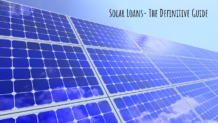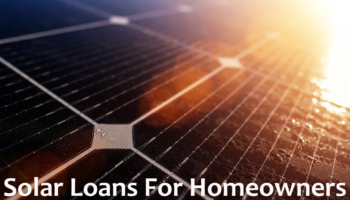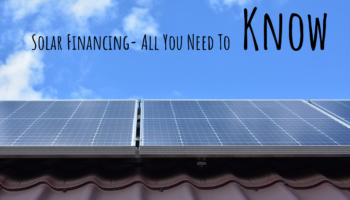Solar loan overview
- There are many solar loan options available to you.
- With a solar loan, you can save 40-70% over the lifetime of your solar panels.
- Many are $0-down loans, and allow you to finance the total amount of your solar panel system.
- Many different types of institutions offer solar loans, from traditional banks to solar panel manufacturers.
- Solar loans have the same basic structure, terms and conditions as other home improvement loans.
- Solar loans offer immediate returns by saving you money on your electricity bills right away, even as you repay the loan.
Most homeowners are aware that solar panels can potentially save them money on their monthly electric bills.
However, many aren’t able to come up with the $15,000-$25,000 it costs to buy a system outright.
The good news is that it is relatively easy to obtain a solar loan that allows you to purchase a solar panel system with little or no upfront costs.
With ownership comes major benefits, added home equity. A recent study from Lawrence Berkeley National Laboratory highlighted clear data that adding solar that is owned by the homeowner adds $4/watt of home equity to the house. So if you have a 5kW or 5,000 Watt system, that’s $20,000 of added home equity to your home.
This guide will explain how solar loans work, and whether they’re right for you.
What is a solar loan?
A solar loan is a loan taken out for the purchase and installation of solar panels. They offer a way for homeowners to invest in a solar panel system without paying lots of money upfront.
Many solar loan providers offer zero-down solar loans and options to pay down a loan early without penalty.
Solar loans are generally considered a subcategory of home improvement loans. As such, they are available with many different payment structures, terms, and rates.
Homeowners are attracted to solar loans because the purchase of solar panels results in immediate utility bill savings. The bill savings can then be used towards the monthly loan repayment.
However, while solar loans are convenient, overall they offer a lower financial return than solar panel systems purchased with cash.
Finance your solar panel system with a solar loan
Solar panel loans are similar to home improvement loans that homeowners have used for decades to build a deck or add a second bathroom to their homes. When a homeowner borrows money from a lender, they agree to pay it back, plus interest, in monthly installments over the loan term.
Solar panel loans have the same basic considerations as other types of loans:
Lower interest rates result in lower overall costs for borrowers.
Loans with shorter terms will generally have higher monthly payments and lower total costs over the life of the loan.
Solar panel loans can be either secured or unsecured, which results in a wide array of interest rates, term lengths, and credit requirements among loan offerings.
Difference between solar panel loans and other home improvement loans
There is one very important difference between solar panel loans and other home improvement loans: a solar panel loan allows you to own an asset that generates significant financial value. This includes both the value of electricity generated by the solar panel system over its lifespan and the 30% federal investment tax credit and other applicable rebates and incentives like solar renewable energy certificates (SRECs). While a new kitchen or deck is a nice addition to your home, they do not offer the same type of financial benefits.
A solar loan allows you to own an asset that generates significant savings.
Do you need a good credit score to get a solar loan?
Not really. Plenty of banks will finance solar systems for the full spectrum of credit ratings.
Solar loan availability has expanded. thanks to the emergence of new solar loan platforms like Dividend Solar, Mosaic, and Greensky. They have enabled most local solar installation companies to offer zero-down financing to their clients.
For residents of California and Florida, there is also the option of residential PACE (R-PACE) loans. PACE loans have no credit score requirements at all.
While not necessary, having a good credit score definitely has benefits. It will open more doors and allow you to negotiate on the interest rate.
Are solar loans tax deductible?
The answer depends on the kind of solar loan that is taken out.
If the solar loan is secured by your home, then yes, all interest and fees on the loans are tax deductible. This is because home improvements such as solar installations are considered capital projects, i.e. those that increase the value of the house, are classified by the IRS as tax deductible.
Solar loans that are unsecured, on the other hand, are not eligible for tax deductions.
Solar loans: what questions you need to ask
Like any other financial product, solar panel loans have different structures, terms, and conditions. In order to find the solar energy loan that is right for you, there are two fundamental questions that you need to ask.
Do you want a secured or unsecured option?
There are two main types of solar loans: secured loans and unsecured loans.
Secured loans are backed by an asset, typically your home. As such they tend to have lower rates, with the APR usually falling between 3-8%. Home equity loans and HELOCs (Home Equity Lines of Credit) are the most common versions of these.
Residential PACE (R-PACE) loans are another example; they are secured through a lien on your property tax. PACE loans are offered to people with lower credit scores, but they typically charge a higher rate than a home equity loan or HELOC.
Unsecured loans, as the name suggests, are offered without an asset offered as collateral. These generally require a good credit score, and the better your credit score, the lower your rate. The APR on an unsecured solar loan can vary from 5.5% to 20%, or even higher.
How much are you willing to pay for each monthly loan installment?
The amount you want to pay each month will impact the interest rate and the length of the loan.
Many solar loans are zero-down, i.e. they require no down payments.
Where down payments are required, they are generally small, typically between $0 and $3,000.
Loans with longer terms will have smaller monthly payments, but you will pay more in interest over the life of the loan. In contrast, payments on solar energy loans with shorter terms may exceed your monthly utility bill savings, but they offer a better value because you pay less in interest over the life of the loan.
Solar loan rates
Secured loans such as home equity loans and HELOC usually have APRs between 3-8.5%, depending on your credit score. The rates on PACE loans tend to be at the higher end of this spectrum, with APRs between 6.5 and 8.5%
The rate range on unsecured loans is much higher. In general, the rates vary from APRs of 6% to 30% or higher. Getting a rate at the lower end usually requires an excellent credit score.
Solar loan down payment requirements
Solar loan lengths
You can find solar loans ranging with maturity periods as short as 3 years to as long as 30 years. However, loan durations of 10-20 years are most common.
The length of the loan and the loan rate are inversely related. That means that the higher the loan length, the lower the loan rate.
Loans are Not Always What They Seem
In order to maximize the savings of a purchased solar system, homeowners have to consider various factors including price, size, and hardware. There are two basic options: pay cash or obtain a loan. Solar systems typically cost $20,000 or more, and we find few customers are willing to pay the entire purchase price up front. Most elect to finance the purchase. Some homeowners will go directly to a lender to obtain a solar loan. The first thing you should know is that most solar loans allow for a homeowner to apply the federal tax credit toward paying down the loan balance. The lenders typically allow between 12 and 18 months after the funding of the loan for the homeowner to pay back up to the total amount of the tax credit (30% of the purchase price). For example, if a solar system cost $20,000 and was fully financed by a lender, the homeowner would be allowed 12-18 months to pay back up to $6,000 without any pre-payment penalties. This allows for the homeowner to have filed his federal taxes and received a refund, if any was due, and then pay down the loan balance with the proceeds of the tax credit.
So, what should you look at amongst the various solar loans available? There are two prominent considerations:
- The true Annual Percentage Rate (APR) of the loan.
- The monthly payments.
The first of these can be tricky. Some lenders tout extremely low nominal rates (some as low as 1.89%). These sound too good to be true – and they are. Because what they don’t tell you is that there is something known as a ‘dealer fee’ embedded in the quoted price of the solar system. These dealer fees can run as high as 17%, and the homeowner is typically unaware that their system’s price has been increased to accommodate this fee. Despite its name, the dealer fee does not benefit any third party, or dealer; rather, it goes right into the pocket of the lender. One prominent solar lender claims to offer a 2.99% APR on its 12 year loan. That sounds great to many borrowers, but the reality is that the effective interest rate they are paying on the true cost of the system is over 6.3%. This is more than double the advertised rate! So, be careful with dealer fees; ask your installer about them before you sign your contract.
Some solar loans are made with what is known as a “same as cash option.” This means that the lender will fund the full amount of the loan, but only collect payments based on 70% of the outstanding balance during the first year or so. This amounts to a 30% discount on your payments for the first 12-18 months. (This makes Day One savings greater than on a traditional loan.) After that point, the homeowner is expected to pay down the loan balance by the amount of the tax credit. In the example used earlier, the homeowner would receive a $20,000 loan but only pay interest on $14,000. If at the end of the 12 month grace period the homeowner fails to pay back the tax credit amount, then the lender will start charging interest on the $6,000 portion from that point forward. But be careful, some lenders will charge retroactive interest back to the first day of the loan. This can be a very unpleasant surprise!
Loan Maturities
Let’s talk about the loan maturities which are typically available in the market. On the short end, you will find 5 year loans, not unlike many car loans. At the long end, there are several 20 year maturities and even a few 25 year solar loans, looking more akin to a home mortgage. There are numerous offerings in between these extremes. So, how to decide amongst all these options? For starters, it should be understood that short-term loans have lower interest rates than long-term loans. A typical 5 year loan may have an effective APR in the 6% range, while a 20 year loan will have rates closer to 8%. It doesn’t seem like a huge difference, but over the course of the respective loans’ lifetimes you might end up paying $12,000 more interest on the 20 year loan on a typical system.
You may ask, why not simply opt for the shorter term loan? The reason is simple: the longer the term, the more time the borrower has to pay down the principal balance of the loan. This allows for smaller monthly payments, a feature many people find attractive. Table 1 below illustrates this dynamic, using actual loan offering from lenders active in the residential solar market. (Assumes purchase of a $20,000 solar system.)
While the 8-year loan featured above has a fairly low lifetime interest cost, the monthly payment will probably not allow for immediate savings on the solar system. That is, the solar system’s monthly payment may actually be higher than the electricity cost which it eliminates. Most people find this to be very unattractive, and opt for a loan with a lower payment. But for a borrower taking a long-term view, the shorter term loan may actually be the best option; because at the end of 8 years he or she will be paying zero for solar, with 100% of the electric savings staying in his pocket. Since solar systems generally have an expected life of 25 years (or longer), that’s at least 17 years of free energy being generated by the panels.
However, if your goal is to maximize cash savings from the moment your system is turned on, then the 20 year loan makes more sense. Many installers have a lender and loan product they are most comfortable using, and tend to promote this without consideration of the homeowner’s needs. Homeowners tend to be too preoccupied with the specifics of the solar equipment they are purchasing to ask questions about the loan they are being offered, particularly the loan maturity. Make sure you look at the loan and maturity options available. If your installer does not give you an array of options, do some research and find an alternative which better suits your needs and preferences.
Good or Bad Debt?
Many financial advisors encourage consumers to avoid debt in most cases, or to at least evaluate whether a debt is good debt or bad debt. In the case of solar, there is compelling evidence that solar debt is a unique case of good debt.
Solar is a very good investment. That same 5kW system which typically costs less than $20,000, will save you over $50,000 over the 25-year life of the system, equal to the length of the solar panel warranties. That’s $50,000 of money not going to your utility, or even your solar lease provider, but to your own pocket, savings, retirement, vacation fund or otherwise. Add to that the $20,000 of home equity that you can capture if you sell your home anytime in the next 25 years, including tomorrow!
The most popular loan customers has a 12-year term, no pre-payment penalties, and interest rates of 2.99-4.99% depending on your credit score. The 12-year term is common because for most customers, their monthly loan payment is equal to or less than their current utility bill. This makes considering solar a similar decision to renting versus buying a home. One of the primary drivers of home ownership is building personal wealth by applying mortgage payments to your loan principal outstanding as well as the long term rising value of real estate.
With all this in mind, consumers can rest assured with a solar loan. Even if they are working an aggressive debt free plan, a solar loan is far superior to a solar lease or your current utility bill.
Affordable Solar Loan Providers
The first homes to install modern photovoltaics were in the 1960s. These early adopters were pioneers in alternative home energy. They took a risk installing new technology. Costs were high and paid in cash. Lucky for them, their financial investment paid off. Those sturdy panels are still producing to this day.
Since those first systems were purchased with cash, the industry has grown and evolved. The solar financing industry has grown parallel to the mass adoption of home solar systems. As more people are looking into alternative energy options for their homes, more financial institutions are seeing opportunity.
Over the years, trends in solar financing have come and gone. For the first 5 years of this decade, the prevalence of Leases (also known as Power Purchase Agreements) rose to prominence. The solar installation company owned the solar system and simply sold the power to the homeowner at a lower rate than their current utility. This was a great way to have solar on your home without any initial cash outlay. Additionally, homeowners could see immediate monthly savings making it appealing to many.
However, solar leases are not able to take advantage of the 30% Federal Incentive Tax Credit (ITC). Only those who purchase and own the system can receive that credit. This reality has led to a decline in leases and PPAs over the last two years.
Financial institutions saw an opportunity in this coverage gap – they could finance the purchase of a photovoltaic system entirely, and allow homeowners to take advantage of the Federal ITC. For many solar-minded homeowners, this is the best of both worlds.
In the current solar market, there are many new solar financing options available. There are options for those with low credit scores, those with some cash to put down, those who want to pay off their loan quickly, those who want a greater immediate savings, etc.
Here’s a solid foundation for the available solar funding options out there.
What other types of solar financing are available
Aside from solar loans, two other types of solar financing that you may come across are solar leases and Power Purchase Agreements (PPAs). Here’s a brief description of each:
Solar leases: You essentially rent a solar energy system and pay a monthly or annual fee to your solar installer.
PPAs: You pay on a cents-per-kilowatt hour (kWh) basis for the energy your solar panels produce. This is similar to a solar lease, just with different payment terms.
Solar leases and PPAs are what is known as third-party ownership models; this is where the solar company retains ownership of the solar panels and charges you for the power.
The big disadvantage with opting for solar leases and PPAs is that you won’t be eligible for generous solar incentives such as the solar tax credit. As such, these forms of financing have fallen out of favor and have been replaced by solar loans, which offers homeowners much better financial returns.
Solar loans: What is your final decision?
For those who have the cash, first consider buying a solar panel system outright. A cash purchase offers the highest return on investment.
However, most homeowners don’t have that sort of liquidity. For those individuals, we recommend exploring solar loans as a way to get solar panels with little or no upfront cash requirements.
Even after accounting for interest on the loan, homeowners can usually earn an excellent return on investment. They’ll also see many other benefits, such as increased property values, reduced reliance on the grid, and a small carbon footprint.
As with all personal large financial decisions, be sure to shop around to make sure you are getting the deal that best suits your needs.
An easy way to check if a solar loan is right for you is by using our solar calculator; it will show you how your monthly utility bill savings will compare with your loan’s monthly payments.
Further Reading








